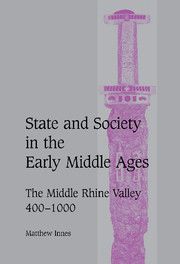Book contents
- Frontmatter
- Contents
- List of figures
- List of abbreviations
- A note on nomenclature and citations
- Acknowledgements
- Map 1 The Carolingian Rhineland
- Map 2 The Carolingian middle Rhine valley
- 1 INTRODUCTION
- 2 MONASTICISM, SPIRITUAL PATRONAGE AND SOCIAL STRUCTURE
- 3 LAND, KINSHIP AND STATUS
- 4 LOCAL POWER: COLLECTIVE ACTION, CONFLICT AND CONSENSUS
- 5 LOCALITY AND CENTRE: MECHANISMS OF EXTRACTION
- 6 POLITICAL POWER FROM THE FIFTH TO THE ELEVENTH CENTURY
- 7 CONCLUSION: STATE AND SOCIETY IN THE EARLY MEDIEVAL WEST
- List of primary sources
- Bibliography of secondary works
- Index
- Cambridge Studies in Medieval Life and Thought Fourth series
1 - INTRODUCTION
Published online by Cambridge University Press: 10 July 2009
- Frontmatter
- Contents
- List of figures
- List of abbreviations
- A note on nomenclature and citations
- Acknowledgements
- Map 1 The Carolingian Rhineland
- Map 2 The Carolingian middle Rhine valley
- 1 INTRODUCTION
- 2 MONASTICISM, SPIRITUAL PATRONAGE AND SOCIAL STRUCTURE
- 3 LAND, KINSHIP AND STATUS
- 4 LOCAL POWER: COLLECTIVE ACTION, CONFLICT AND CONSENSUS
- 5 LOCALITY AND CENTRE: MECHANISMS OF EXTRACTION
- 6 POLITICAL POWER FROM THE FIFTH TO THE ELEVENTH CENTURY
- 7 CONCLUSION: STATE AND SOCIETY IN THE EARLY MEDIEVAL WEST
- List of primary sources
- Bibliography of secondary works
- Index
- Cambridge Studies in Medieval Life and Thought Fourth series
Summary
REGION, SOURCES AND SCOPE
On the morning of 18 January 838 an earthquake hit the middle Rhine valley. One local observer recorded this prodigy for posterity in his account of his time. Disruption occurred ‘at St Nazarius and in the regions of Worms, Speyer and Ladenburg’. The geographical focus of this study coincides neatly with the epicentre of the 838 earthquake, and, just as tremors must have been felt well beyond this immediate area in 838, so on occasion in what follows we will also move beyond the Rhine valley. Our observer, probably writing at Mainz, identified the region in terms of four important centres. Worms and Speyer were both seats of bishops, under the jurisdiction of the archbishop of nearby Mainz: all three bishoprics stood on the site of Roman cities on the Rhine's west bank; Mainz and Worms were vibrant urban centres already in the ninth century, although Speyer remained a backwater until royal patronage in the eleventh century effected a transformation. East of the river, Ladenburg likewise stood on a Roman fortified site, but lacked a bishop. It was, nonetheless, an important local centre which was described by some Carolingian observers as a city: hence in the description of the 838 earthquake it was acknowledged as a central place which supplied an identifying label for its rural hinterland.
- Type
- Chapter
- Information
- State and Society in the Early Middle AgesThe Middle Rhine Valley, 400–1000, pp. 1 - 12Publisher: Cambridge University PressPrint publication year: 2000
- 1
- Cited by

